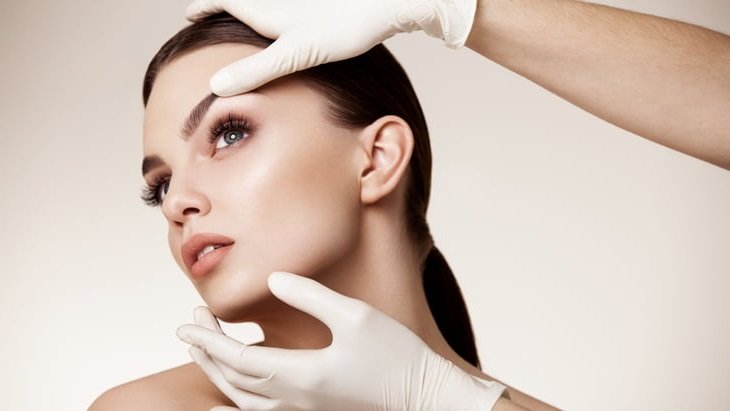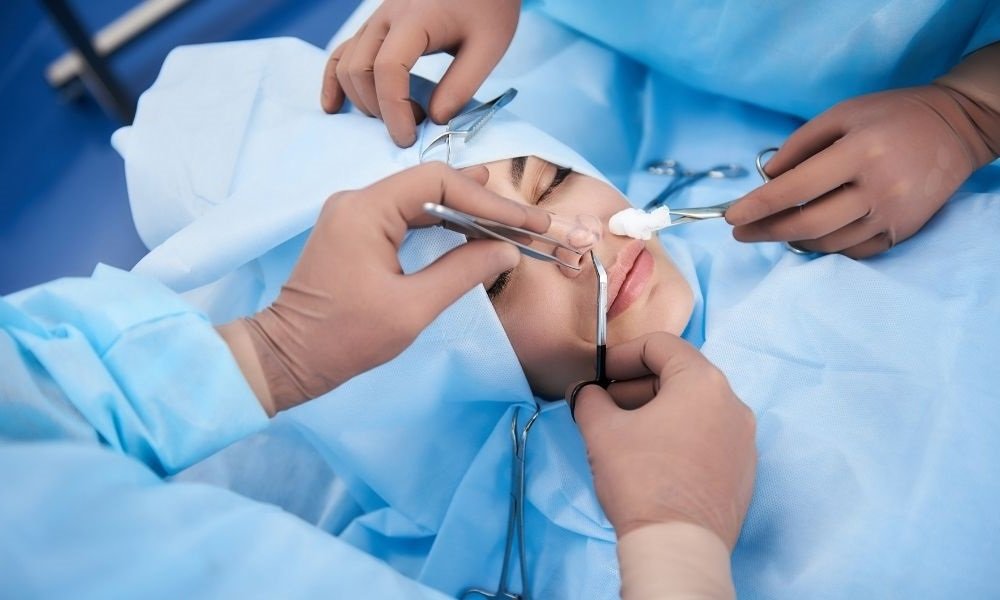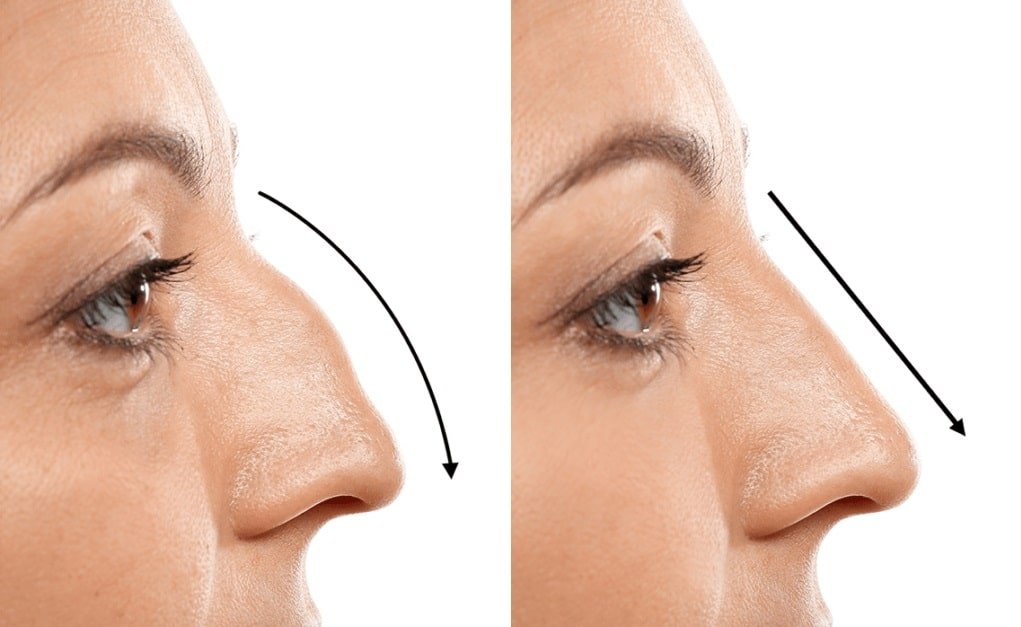Rhinoplasty (RIE-no-plas-tee) is a surgical procedure that alters the nose’s appearance. The reason for rhinoplasty could be to alter the appearance of the face, enhance breathing, or both.
The upper part of the nose structure is composed of bone, and the lower part is cartilage. Rhinoplasty can alter cartilage, bone, or any combination of the three. Discuss with your surgeon the correct rhinoplasty procedure for your needs and exactly what you could accomplish.
If you are considering rhinoplasty, it is essential to consider the other features of your face, the skin on your nose, and the features you’d like to change. If you’re an ideal candidate to undergo surgery, the doctor will create a bespoke strategy specifically for you.
Sometimes all or part of a rhinoplasty procedure is insured by insurance.
What’s the reason for it?
Rhinoplasty could alter the shape, size and proportions of your nose. It could be performed to fix deformities caused by an injury, fix a congenital disability, or improve breathing difficulties.
Risks
Like all major surgeries, rhinoplasty is not without risks, including:
- Bleeding
- Infection
- A reaction that is not expected to occur from the anaesthesia
Other risks that could be associated with the rhinoplasty procedure include, but aren’t restricted to:
- Trouble breathing through your nose
- Numbness that lasts forever around and in your nose
- The possibility of an unnatural-looking nose
- Swelling, pain, or discolouration that can last
- Scarring
- A septum-wide hole (septal perforation)
- The need for further surgery
Consult your physician about the risks that apply to you.
How do you create?

Before scheduling rhinoplasty surgery, you should talk to your surgeon to discuss critical factors determining if the procedure will work for you. This usually comprises:
- Your medical background. The most critical questions your doctor will ask you are about the reason to undergo surgery and what you want from it. Your doctor will also inquire questions regarding your medical history, for example, a background of nasal obstructions or surgeries, as well as any medication you are taking. If you suffer from bleeding disorders like haemophilia, for instance, or haemophilia, you might not be a good candidate for nasal surgery.
- A physical exam. Your doctor will conduct a complete physical exam, including any tests performed in the laboratory, like blood tests. The doctor will also look at your facial features and the exterior and interior of the nose.
- The physical exam will help your doctor decide the changes that must be made and how the physical characteristics like the size of your nose or the strength of your cartilage that runs along the top of your nose could impact the outcomes. A physical exam is crucial to determine the effect of rhinoplasty on your breathing.
- Photos. Someone from your doctor’s office will snap photos of your nose at different angles. Your surgeon could employ computer software to alter the images to show what results are feasible. The doctor may use photographs for assessing before and after, reference during surgery, and longer-term evaluations. The most important thing is that the images allow for a discussion specific to the objectives of the procedure.
- An explanation about your goals. You and your doctor should discuss your motives and expectations. The doctor will be able to discuss what rhinoplasty will and will not do for you and what the results could be. It’s normal to feel embarrassed about your appearance. However, it would be best if you communicated to your surgeon your goals and desires for the procedure.
- If you’ve got a narrow chin, your doctor may consult you about undergoing an operation to increase the size of your chin. A small jawline can give the impression of a more prominent nose. It’s unnecessary to undergo surgery on the chin in these circumstances; however, it can help create a more balanced facial profile.
After the procedure has been scheduled, you’ll have to arrange for someone else to transport you home, If you have an outpatient procedure.
In the initial few days following the anaesthesia, there could be memory issues, a slower reaction time, and impaired judgement. Therefore, you should arrange for someone from your family or friends for you to be with them for one or two nights to assist with personal tasks after you have recovered from surgery.
Medicines and food
Do not take medications containing aspirin or ibuprofen (Advil, Motrin IB or other) over two weeks before and following surgery. These drugs can cause bleeding to increase. Use only the medicines that have been approved or prescribed by your doctor. Beware of herbal remedies and other over-the-counter remedies.
If you smoke, stop smoking. Smoking slows healing following surgery and can increase the likelihood that you develop an infection.
What are the things you can be prepared to
Rhinoplasty is not an organized sequence of steps. Each procedure is individual and tailored to meet the specific anatomy and objectives of the patient who is having the procedure.
During the operation

Rhinoplasty is a procedure that requires local anaesthesia, general or sedation, according to how intricate the procedure is and which the surgeon would prefer. Consult your physician before surgery about what type of anaesthesia is best for you.
- Local anaesthesia includes the use of sedation. This type of anaesthesia is generally utilized in an outpatient environment. It is restricted to a particular region within your body. Your doctor injects an opioid into your nasal tissues. They relax you using medication injected via the IV (IV) tube. The result is that you are groggy but not asleep.
- Anaesthesia for general use. You receive the medication (anaesthetic) through inhalation or a small tubing (IV line) put into the vein of your neck, hand or chest. General anaesthesia can affect your entire body, causing you to fall unconscious during surgical procedures. General anaesthesia requires a breathing tube.
Rhinoplasty can be performed inside the nose, or by an external cut (incision) near the base of your nose, in between your nostrils. The surgeon will likely readjust the cartilage and bone underneath your skin.
Your surgeon may alter the form of cartilage or nasal bones in various ways based on the amount of cartilage that needs to be taken out or changed to the structure of your nose and the materials available. For minor changes, the surgeon could use cartilage located inside your nose or your ear. For more extensive modifications, the surgeon could use cartilage from your ribs implants, bone or different parts within your body. After the changes have been made, the surgeon will place the nose’s skin and tissues back and stitches the incisions within your nose.
If the septum’s wall between the two nose sides (septum) can be bent (deviated), the surgeon can also make adjustments to help improve breathing.
After the procedure, you’ll be in a recovery area, where staff members monitor your recovery to a state of consciousness. It’s possible to leave later in the day, or if you’re suffering from another health issue, it is possible to stay overnight.
Following the operation
After surgery, you’ll lie in bed with your head elevated over your chest to prevent swelling and bleeding. The nose could be swollen due to swelling or the splints you have placed inside the nose after surgery.
In most cases, the internal dressings stay in place for one to seven days following the surgery. The doctor may also apply a splint on your nose to protect and help. It’s typically placed for around a week.
The slight bleeding and the drainage of blood and mucus are typical for a few days following the procedure or after the dressing removal. The doctor might place the “drip pad” — a tiny piece of gauze held by tape on your nose to help absorb the drainage. The gauze should be changed as instructed by your physician. Do not place the drip pad in a tight position against your nose.
To reduce the risk of swelling and bleeding, your physician may suggest you adhere to the following precautions for a few weeks following the surgery. Your doctor might ask you to:
- Avoid strenuous exercises like running or aerobics.
- Bathe instead of showering when you’ve got bandages covering your nose.
- Do not blow your nose.
- To prevent constipation, consume foods with high fibre content like vegetables and fruits. Constipation can lead to strain, placing pressure on the site of surgery.
- Avoid extreme facial expressions, like smiles or laughter.
- Use a gentle brushing technique to prevent the movement of your upper lip.
- Dress in clothes that are fastened at the front. Don’t put clothing like shirts or sweaters on top of your head.
Additionally, you shouldn’t put glasses or eyeglasses on your nose for at least four weeks following surgery to avoid the pressure from your nose. You can make use of cheek rests, or you can tape sunglasses to your forehead till the nose has fully healed.
Make sure you apply SPF 30 sunscreen outdoors, particularly around your eyes. Prolonged exposure to sunlight can cause permanent irregular discolouration of the skin around your nose.
Temporary swelling or black and blue discolouration of your eyes can be seen for 2 to 3 weeks following the procedure. The swelling of the nose can take longer to disappear. Restricting sodium in your diet can reduce swelling quicker. Do not put anything like cold or ice packs on your nose following surgery.
The appearance of your nose will change throughout your life regardless of whether you’ve had the procedure or don’t. Because of this, it’s hard to determine what you’ve achieved as the “final result.” But, the majority of swelling will disappear within one year.
Results
A few minor modifications to the shape of your nose, typically measured in millimetres, could significantly impact how your nose appears. In most cases, an experienced doctor can produce results you are pleased with. However, in certain instances, it is the case that the small changes won’t be enough to satisfy you, and you, as well as your surgeon, may decide to have a second procedure for more significant modifications. If this happens, it is recommended to be patient for at least one year to have the follow-up procedure since your nose could change in this period.
Clinical studies
Discover Clinic studies of procedures and tests to prevent, detect and treat conditions.
Frequently Asked Questions
What are the differences between rhinoplasty and septoplasty?
Rhinoplasty is a surgical procedure used to alter the shape of the nasal area. Since breathing and the shape of the nose are closely linked, a rhinoplasty may be needed to alter how the nose appears and improve breathing through the nose.
Septoplasty is a procedure to improve breathing by straightening out the nasal septum, which divides nasal passages into the left and right parts (nasal septum). The septum is bent and narrow. Breathing is difficult via nasal passages. A septoplasty is usually performed in conjunction with rhinoplasty.
Does rhinoplasty require any special skills?
No. Rhinoplasty can be a complex operation. It is because of a variety of reasons. The nose is a complex 3D shape located in the middle of the front of your face. The changes made by rhinoplasty are usually very minor. However, they can significantly change how the nose appears and operates since the changes aren’t significant as well, as the margin of error.
The swelling and placement of local anaesthetics within the skin can distort the nose when undergoing surgery, concealing the subtle changes that occur. Rhinoplasty is also not any standard procedure or sequence of steps. The surgeons customize each procedure to the requirements of the particular patient.
Do I have to remain at the hospital?
Nearly every person who undergoes Rhinoplasty can be discharged from the hospital the next day following the surgery. In some cases, there is the possibility of staying at the facility for an entire night if you’re experiencing an issue suffering from nausea or have other health conditions that require to be checked.
What is the length of the recovery time?
Take the week away from school, work or any other obligations. You’ll feel better with each passing day of the initial week. A week after surgery, patients usually feel like they’ve been back.
Following surgery, there’ll occur some swelling. It can take months to disappear. However, most people forget about it after a few months. Most people are back engaging in most activities within an entire week. They can resume any activity after about two or four weeks.
Are there any risks?
All surgeries come with potential risks. However, the risks of rhinoplasty are low, and complications are infrequent. The doctor will inform you about the risks and advantages before the procedure.
Do insurance companies pay for rhinoplasty?
Sometimes insurance companies pay for rhinoplasty, but it’s contingent on the insurance company’s policy. Before you schedule surgery, the doctor’s office can help you obtain prior written approval from your insurance provider. While this doesn’t require assurance of coverage, it’s one of the best ways to ensure that rhinoplasty is covered benefit. In some cases, insurance will cover one part of the procedure but not the other components. In such cases, you can call the business office for an estimate for the procedure.
What’s the price for rhinoplasty?
The cost of rhinoplasty is based on many aspects, such as the complexity of the procedure, the surgeon’s experience and training experience, and the location. The surgeon at Clinic, the procedure cost is the same no matter the surgeon you pick.
Do I get a glimpse of what my nose could appear after surgery?
Yes. Before you visit, your physician will be taking stock photos of various views of the face. The photos can be altered to give you an idea of what your nose may appear like the following surgery.
Are rhinoplasty procedures painful?
It’s not for everyone. After a day, most people feel pain between 0 to 4 out of 10.
Do you want to pack my nose?
No. It can be uncomfortable to pack. You’ll probably find soft splints inside your nose. They have holes that allow you to breathe through them at the very least for some days. The doctor can easily take them off during the one-week checkup.
How do I expect to be bruised for how long?
It is rare to see bruising. It generally lasts for about a week if you do suffer from minor bruising.
What should I be looking for in an experienced surgeon?
Facial plastic surgeons and Plastic Surgeons, or Otolaryngologists (ENT), do most rhinoplasties. A board-certified training program and board certification in one of these areas can be a great starting point. You will likely need a surgeon who frequently performs rhinoplasties.
You’ll probably prefer a surgeon with good standing with patients and other doctors. Suppose the surgeon you choose has published some research papers in the medical literature related to rhinoplasty and has been invited to talk at educational conferences. In that case, this is usually a sign that their peers respect them in rhinoplasty.
You must ensure that your procedure is performed at an accredited hospital or surgical facility. You should be at ease with the surgeon. Find a doctor who will explain to you in a way that is easy to comprehend what’s going to occur during your procedure.




